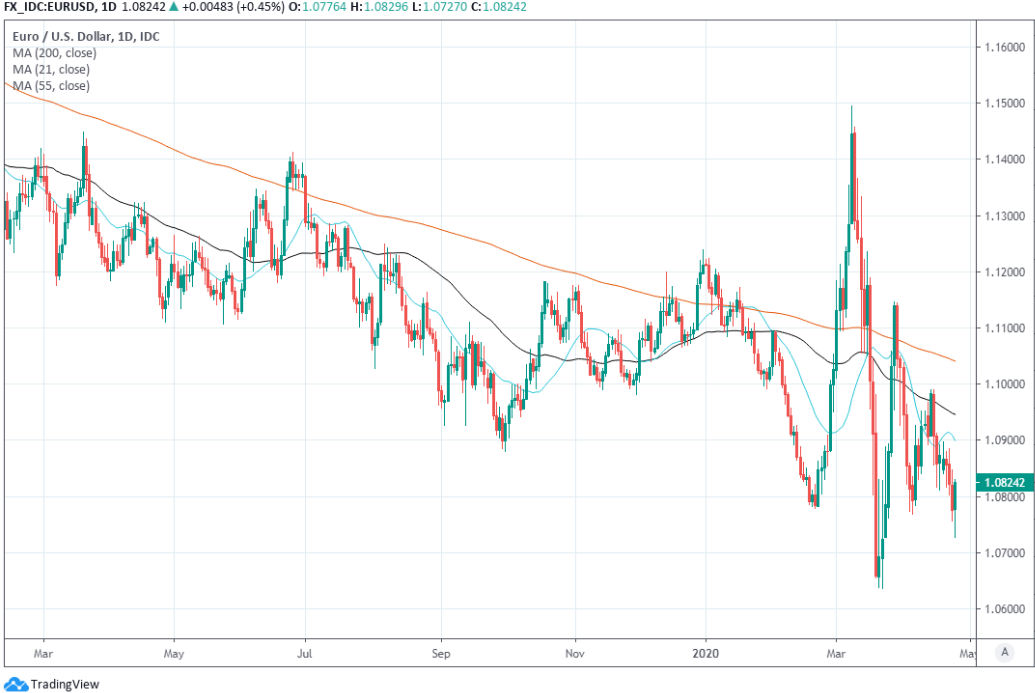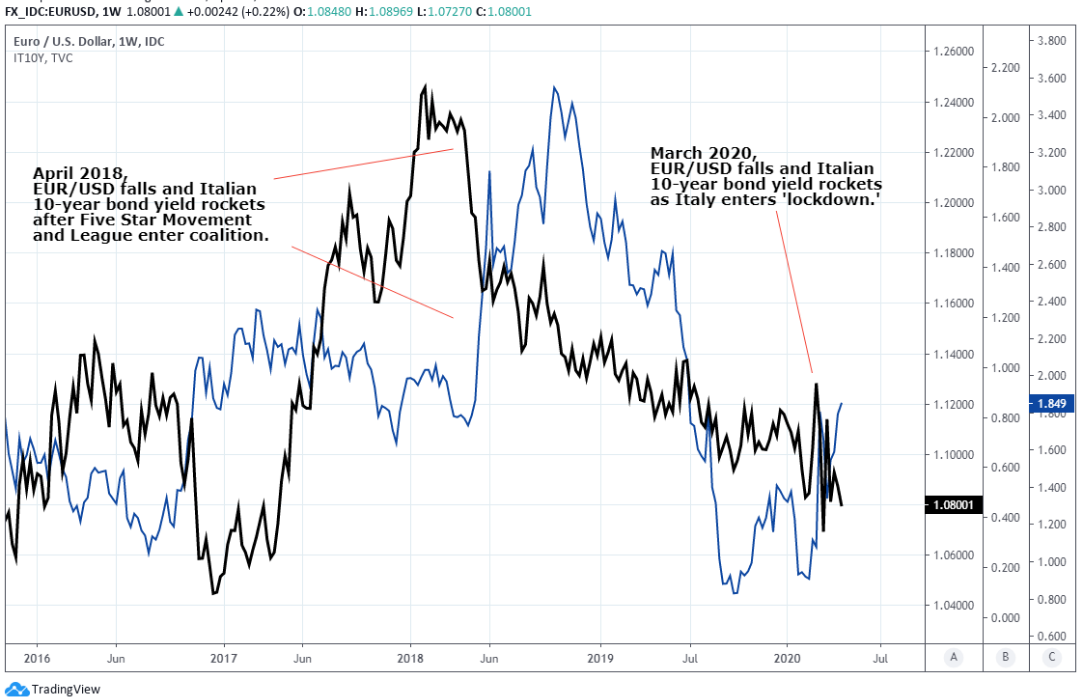Euro-to-Dollar Week Ahead: Rising from the Ashes of Corona Quarrel as ECB Saves Day Again
- Written by: James Skinner
- EUR/USD recovery off 1.0756 has scope to extend further.
- 1.0885 in focus ahead of 1.0947 and 1.0994 in days ahead.
- Moves to reopen economies could lift EUR, risk up ahead.
- ECB support for periphery bonds could further lift the EUR.

© European Central Bank, reproduced under CC licensing
- EUR/USD spot at time of writing: 1.0818
- Bank transfer rates (indicative): 1.0442-1.0518
- FX specialist rates (indicative): 1.0659-1.0724 >> More information
The Euro-to-Dollar rate closed the almost half a percent lower on Friday but a last minute recovery from earlier lows has left the single currency well positioned to advance further early in the new week ahead of a European Central Bank (ECB) meeting that could also offer reasons to cheer.
Europe's single currency climbed steadily Friday after having entered on the back foot, with the recovery coming alongside declines in Italian and Spanish government bond yields, which had risen earlier in the week and posed as a headwind to the Euro. This cut the Euro-to-Dollar rate's weekly loss from -0.98% to -0.47% and any further declines in those yields might enable the single currency to reduce its outstanding -3.5% 2020 decline.
Price action led the single currency to establish a new April low around 1.0727 on Friday but the trip down was short-lived and soon gave way to a rebound that technical analysts tip to continue over the coming days.
"EUR/USD is expected to recover from yesterday’s low at 1.0756 and targets the 1.0885 April 22 high. Once bettered the 55 day moving average at 1.0947 and April 15 high at 1.0994 will be back in the frame. Currently unexpected failure at 1.0756 on a daily chart closing basis would target the 1.0636 March low and then1.0340, the 2017 low," says Axel Rudolph, a senior technical analyst at Commerzbank. "A rise above the 61.8% Fibonacci retracement at 1.1167 would be needed for the December high at 1.1240 to be back in play."
A Euro-to-Dollar extension higher this week would probably require a supportive environment for other risk assets like stocks and commodities, although this might be likely given that some countries are increasingly seeking to reopen their economies from coronavirus-induced shutdowns.
This is as the number of new cases detected in major economies on a daily basis remains on a downward trajectory.
Above: Euro-to-Dollar rate shown at daily intervals with key moving-averages marked out.
The domestic financial highlight of the week will be the Thursday 12:45 European Central Bank policy decision and press conference led by President Christine Lagarde, who might offer some reasons for cheer this time out. The Euro-to-Dollar rate needs reasons to cheer because after having entered 2020 with markets looking for a steady rise throughout and to 1.15 by year-end, increasing numbers now tip 1.05 at the 2020 curtain close while some even see it falling as low as 1.02 by the end of June.
This is after European Council agreed in principle to endorse an eagerly-awaited recovery fund but deferred decisions over the size and nature of its financing until May 06, which was a widespread disappointment to a market that was hoping leaders would agree to a form of mutualised financing for loans or grants to the member states hardest hit by the coronavirus crisis. EU leaders also endorsed the Eurogroup's €540bn aid package.
The outcome of Thursday's meeting means the recovery fund, if it materialises, won't operate before January 2021 despite that many economists expect the actual recovery from the coronavirus-lockdown-induced economic collapse could begin as soon as next month. This is after the debate ahead of the meeting helped to stoke the fires of Euroscepticism in Italy, given a perceived lack of solidarity and that the €540bn rescue package requires Eurozone members to use a crisis era bailout fund.
There are myriad potential consequences that could arise from this but in the short-term at least, some parts of the Eurozone are condemned to a slower recovery from the coronavirus trough than would otherwise have been the case and the continent if-not the world might need to rely increasingly on the European Central Bank to prevent a financial crisis and/or 'liquiduity' crisis on the periphery of Europe. This makes Thursday's ECB policy decision and press conference especially important.
Above: Euro-to-Dollar rate shown at weekly intervals alongside Italian 10-year bond yield.
"A firm majority of countries are in favor of Coronabonds, but we also reckon that it would be fairly easy to find a majority in favor of forcing Warren Buffet to pay for dinner in a 27-person-wide dinner company. The only difference between the two is that Buffet never voluntarily joined a club with a common currency. Germany is probably never going to accept to pay everything for everyone," says Andreas Steno Larsen, a strategist at Nordea Markets. "This leaves the ECB as the only game in town (more on that in a sec), even if they ultimately also need political blessing to buy the amount of bonds that could be needed to keep everything afloat in the Euro area."
As a mimimun, analysts expect the ECB to make clear on Thursday that it stands ready to increase the size of it pandemic-emergency-purchase-programme (the coronavirus QE or bond buying programme) if necessary. This after periphery economy bond yields surged through March and April as investors recoiled in horror at the thought of heavily indebted economies pushing their budget deficits near to or above 10% of GDP as they seek to backstop their economies amid the coronavirus shutdown.
Without a 'corona bond' and in the absence of further ECB intervention, Southern European demands placed on the bond market could see financing costs rise to unsustainable levels as debt piles grow larger, setting the clock ticking on a potential timebomb in some of Europe's largest economies. And that's assuming the markets don't simply end up saying no and leaving those weaker and more financially vulnerable economies in the lurch in the process.
That's why analysts and the wider market see a large increase in the €750bn pandemic emergency purchase programme as being only a matter of time, although on this occassion such action might come as a relief to the Euro. QE crushes bond yields and is normally bad for currencies for that reason but the Euro has a negative correlation with Italian bond yields during times of crisis and its those yields that would fall the most in response to any further pledges of support for the periphery bond market.
"The ECB will probably have to buy (a lot) more as they are the only game in town. Even if a QE program is both theoretically and practically negative for the underlying currency, we would still argue that a whatever it takes 2.0 QE program could turn into a EUR-positive, rather than the opposite. Gluing the ship together again matters more for the EUR-pricing than the size of the monetary base," says Nordea's Larsen.






